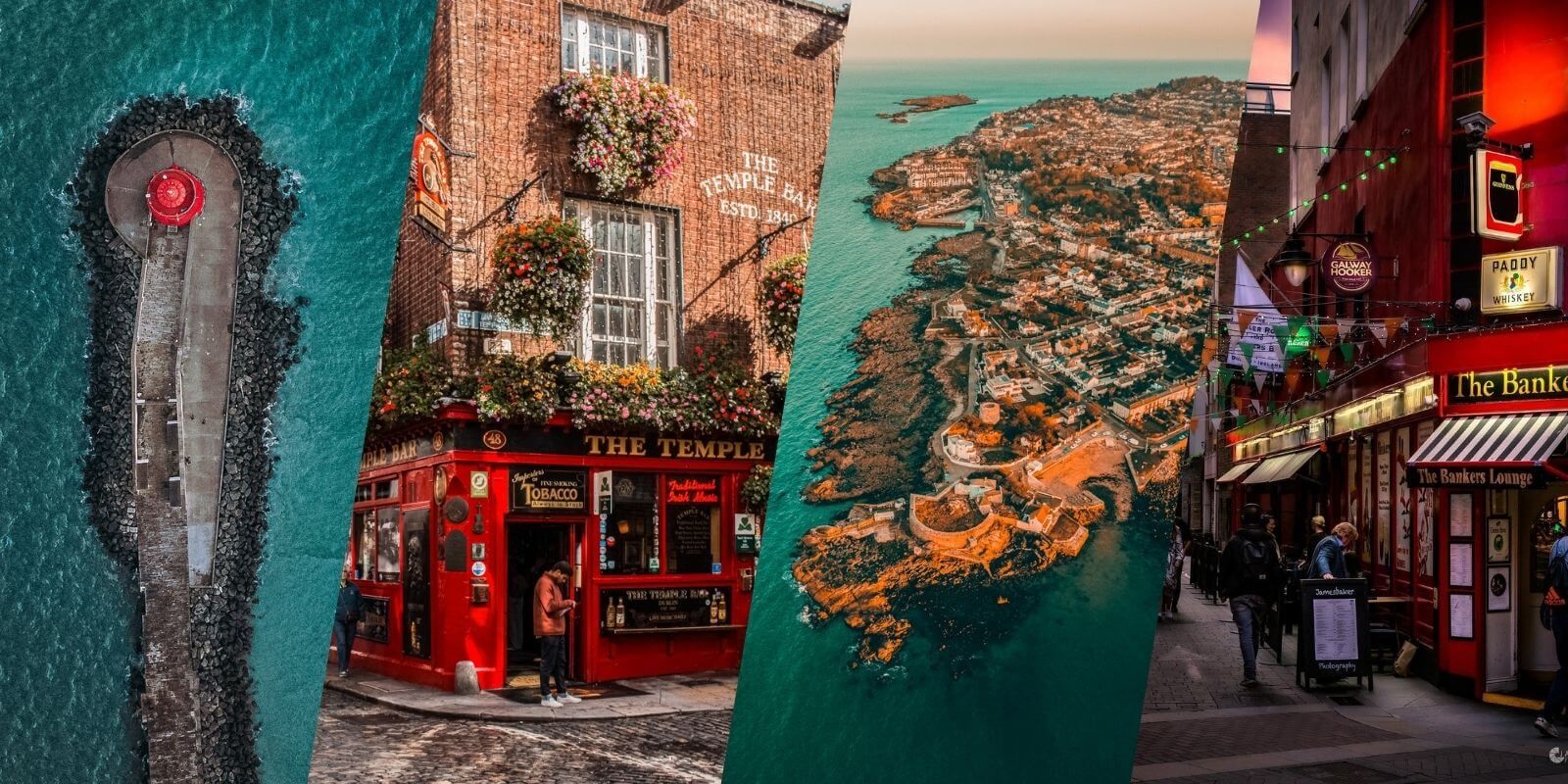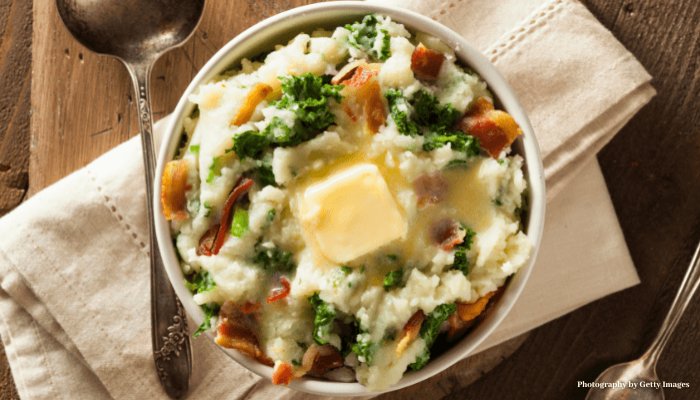Dublin, the vibrant capital of Ireland, is a city known for its rich history, captivating culture and warm hospitality. When it comes to culinary delights, Dublin boasts a diverse range of traditional foods that reflect the country's gastronomic heritage.
-
Traditional Irish Food in Dublin for Tourists: Explore Dublin's rich traditional Irish cuisine, featuring classics like Irish stew, coddle, soda bread and more.
-
Where to eat traditional Irish Food in Dublin: Find recommendations for authentic restaurants and pubs where locals and travelers savour these iconic dishes.
-
Best Irish dishes do try in Dublin City Centre: Gain insights into the culinary history and unique flavours that define Dublin.
-
(FAQ) Frequently asked questions about Irish food, must-try dishes and dining out in Dublin.
Traditional Irish food tells the story of hardship and resourcefulness, comfort and celebration. From hearty Irish stews to sweet treats like barmbrack, this guide will walk you through iconic Irish foods and the best spots in Dublin to savour them. Whether you're a foodie or just curious, get ready to discover the flavours that make Dublin's cuisine truly unforgettable. Irish cuisine is rooted in tradition and hearty flavours. Discover Dublin’s culinary heritage through classic dishes and the best places to savour them in the city.
From hearty stews to freshly baked bread, Dublin has a plethora of traditional dishes that trace back to its culinary roots. As a backpacker or traveller in Dublin, you don't want to miss out on the opportunity to try some of these delicious dishes. Join us as we embark on a gastronomic journey to discover the most traditional foods in Dublin and the best places to savour them.
1. Irish Stew & Guinness Beef Stew:
Irish stew is perhaps the most iconic traditional Irish dish, a warm and satisfying bowl of slow-cooked lamb or beef, potatoes, carrots, onions and parsley. It’s a rustic, no-fuss meal that showcases the essence of Irish cooking: simplicity, heartiness and using what’s locally available. It has long been a comfort food for Irish families, perfect for chilly weather and always served piping hot.
The Guinness beef stew is a richer alternative, using Ireland’s famous stout to create a deep, malty gravy that complements the tenderness of slow-braised beef. The stout brings a slight bitterness that balances beautifully with the sweetness of root vegetables, offering a layered and indulgent twist on the classic stew.
Where to try Irish Stew in Dublin? The local favourite irish pub food, at The Boxty House or at The Church
2. Dublin Coddle
Dublin coddle is a uniquely local dish, famously thrown together with whatever leftovers were available. Traditionally, it’s made by layering sliced sausages, rashers of bacon, potatoes and onions, simmered gently until the ingredients melt together into a soft, flavourful stew. There’s no set recipe, and that’s part of its charm, it varies from household to household, each version with its own twist passed down through generations.
This humble dish has roots in working-class Dublin and was often prepared as a way to use up food before the end of the week. The slow-cooking process allows all the ingredients to soak up each other’s flavours, resulting in a nostalgic, comforting meal with deep cultural roots.
Where to try Dublin Coddle? Try the traditional Dublin Coddle at The Brazen Head or at Murray's Bar
3. Dublin Coddle Pie
Coddle pie is a delightful twist on the traditional coddle, combining layers of bacon, sausages and vegetables with a flaky pastry crust. It's a true taste of Dublin's culinary innovation. A creative evolution of the classic stew, Dublin coddle pie wraps all the goodness of a traditional coddle inside a buttery, flaky pastry crust. It’s a perfect example of how Irish cuisine continues to adapt and evolve, adding a more structured and portable form to a typically soupy dish.
Each bite delivers a blend of juicy sausage, smoky bacon, and tender potatoes, all baked into a golden crust that adds a satisfying crunch. It’s comfort food with a twist. Familiar yet inventive, making it especially popular in gastropubs and modern Irish kitchens.
Where to try Dublin Coddle Pie? You wil lfind the best Irish pies in Dublin at The Auld Dubliner or Gallagher's Boxty House.
4. Fish and Chips:
Fish and chips may have originated in England, but Ireland has embraced this classic dish with open arms. Leo Burdock, a beloved institution since 1913, is the perfect place to enjoy crispy, golden fish and chips. Their secret recipe and commitment to using fresh ingredients have made them a favourite among locals and visitors alike. Traditionally made with fresh cod or haddock, the fish is deep-fried in a golden batter and served with thick-cut chips, salt and vinegar, and often a side of mushy peas or tartar sauce.
What makes the Irish version so special is the freshness of the fish, often caught locally and the careful attention to texture: light and airy batter, chunky and crisp chips. It’s fast food with soul, typically enjoyed after a day out exploring the city or as a satisfying end to a pub night.
Where to try Fish and Chips in Dublin? Try at Leo Burdock or at Arthur's Pub

5. Dublin Bay Prawns:
Also known as scampi or langoustines, Dublin Bay prawns are a native delicacy with a slightly sweet and rich flavour. They’re often served grilled, fried or in creamy seafood dishes. Their texture is firm yet tender and when cooked correctly, they simply melt in your mouth.
These prawns are prized for their quality and freshness, harvested from the Irish Sea just off Dublin’s coast. Often featured in upscale and casual seafood dishes alike, they’re a must for anyone interested in exploring Ireland’s seafood bounty.
Where to try Dublin Bay Prawns? Seafood restaurants in Dublin near River Liffey, The Winding Stair (book in advance) or at the Klaw
6. Corned Beef and Cabbage:
Corned beef and cabbage, while often associated with Irish-American traditions, actually has its origins in Irish history. The dish features salt-cured beef, slow-cooked until it’s fork-tender, paired with soft, buttery cabbage and sometimes potatoes or carrots.
Though it became more popular abroad due to economic changes, the flavours still resonate deeply in Ireland—salty, comforting, and tied to family meals and holidays. It’s a filling, robust dish that speaks to the resourceful and hearty nature of Irish cuisine.
Where to try Corned Beef and Cabbage? This Irish Holiday food you must try, you can find at The Boxty House or at The Woollen Mills
7. Traditional Irish Stew Pie:
Imagine the warmth of a traditional Irish stew, but encased in a golden pastry shell. That’s what makes the Irish stew pie so special: a beautiful combination of soft, slow-cooked meat and vegetables with the crunch of baked pastry.
It’s the kind of dish that turns a classic into something just a bit more indulgent, offering the same hearty flavours in a format that’s easy to serve and perfect for pub menus. Ideal for a cosy evening, it brings tradition and comfort together in every bite.
Where to try Traditional Irish Stew Pie? At cosy Irish pubs with traditional food in Dublin, The Old Spot or at The Cobblestone
8. Barmbrack:
Barmbrack is a lightly spiced fruit loaf traditionally eaten around Halloween, though enjoyed all year round nowadays. Packed with raisins and sultanas, it’s slightly sweet and often served sliced with butter or jam. What makes it unique is its moist texture and subtle flavour of tea or whiskey, often used to soak the dried fruit.
Traditionally, barmbrack included symbolic items baked into it like a coin or ring, each with its own meaning. Today, it remains a nostalgic and beloved treat, especially paired with a cup of tea during a relaxing afternoon.
Where to try Barmbrack in Dublin? This Irish Halloween traditional dessert, you will find at Il Valentino (formely Queen of Tarts) or at The Pepper Pot
9. Boxty Pancakes:
Boxty is a traditional Irish potato pancake, made with a mix of mashed and grated raw potatoes, flour and buttermilk. It can be pan-fried, baked or even grilled. Its flavour is earthy and rustic, and it’s often served with savoury fillings like eggs, bacon or smoked salmon.
Boxty is sometimes called "poor man’s bread", historically used as a way to stretch out ingredients during tough times. Today, it’s a symbol of Irish culinary identity, simple, tasty and surprisingly versatile.
Where to try Boxty Pancakes? The best boxty pancake in Dublin for breakfast or lunch is at Gallagher's Boxty House
10. Soda Bread:
Soda bread is a staple in every Irish kitchen. Made using baking soda instead of yeast, it has a dense crumb, a tangy taste from buttermilk and a crusty exterior. Variations include adding oats, seeds or dried fruit, but even the plain version is full of flavour.
Best enjoyed fresh, this bread is perfect with soups, stews or simply slathered in Irish butter. Its simplicity and quick preparation have made it a beloved favourite for generations.
Where to buy fresh Irish Soda Bread in Dublin and surrounding? When in Dublin, head to Bewley’s Grafton Street Café or Brother Hubbard. When surrounding, try at The Bretzel Bakery or at The Happy Pear
11. Bangers and Mash:
Bangers and mash is one of the ultimate comfort foods, combining juicy pork sausages and fluffy mashed potatoes, usually topped with a rich onion or Guinness gravy. The term "bangers" dates back to World War I, referring to sausages that would burst when cooked due to extra water in the mix.
It’s a classic pub dish: filling, simple and satisfying. The contrast between creamy mash and the crispy outer layer of the sausages makes it a true crowd-pleaser and a must-try for visitors to Ireland.
Where to find traditional Irish Pusb with classic menu? At The Old Storehouse or at The Hairy Lemon
12. Irish Coffee:
Irish coffee is the perfect blend of strong coffee, smooth Irish whiskey, a bit of sugar and a layer of thick cream floating on top. The drink was first invented in the 1940s to warm up weary travellers and remains a staple in Irish hospitality.
More than just a drink, Irish coffee is a ceremony. The balance of bitter coffee, boozy warmth and creamy texture makes for a delightful after-dinner treat or an indulgent break from exploring the city.
Where to find this classic Irish Whiskey drink in Dublin? At The Temple Bar Pub or The Long Hall
13. Irish Breakfast:
The traditional Irish breakfast is a hearty, protein-packed meal that showcases the essence of Irish cuisine. It usually includes a rich variety of components such as crispy rashers (Irish bacon), juicy sausages, black and white pudding, grilled tomatoes, fried eggs and toast slathered in butter. Each bite offers a warm and comforting taste that has made this breakfast a long-standing favourite across Ireland.
Often accompanied by a strong cup of tea or freshly brewed coffee, it’s more than just a morning meal: it’s a ritual, a cultural experience and the perfect way to start your day before diving into Dublin’s sights. For those looking for something lighter, a mini Irish breakfast offers a smaller portion of the traditional staples while still delivering the same authentic flavour.
Where to find the best full Irish Breakfast in Dublin City? At O'Neill's Bar & Restaurant or Lemon Jelly Café
14. Black Pudding:
Black pudding is one of the most distinctive ingredients in Irish cuisine. Traditionally made from pork blood, oatmeal, onions and spices, it has a rich, earthy flavour and a dense, crumbly texture. Often served as part of a full Irish breakfast, this unique delicacy has long been a staple in Irish households and is deeply rooted in the country’s culinary heritage.
While it may sound unusual to some, black pudding is appreciated for its bold taste and ability to complement the other components of a savoury breakfast plate. For the adventurous eater, it offers an authentic glimpse into Ireland’s rural food traditions and proves that sometimes, the simplest ingredients create the most memorable flavours.
Where to eat Black Pudding in Dublin? At Murray’s Bar, O'Neill's Bar & Restaurant, The Bank (College Green) or at The Boxty House
15. Sheperd's Pie
Shepherd’s Pie is classic Irish comfort food at its finest. This traditional dish features pulled or diced lamb cooked with carrots, onions and peas in a thick, savoury gravy, all topped with a layer of creamy mashed potatoes. It’s then baked until the top is golden and slightly crisp, creating a satisfying balance of textures.
Rich, filling and full of homestyle goodness, Shepherd’s Pie is the kind of meal that warms you from the inside out. Its cousin, Cottage Pie, uses beef instead of lamb, but both versions are deeply associated with traditional Irish cooking and are perfect for cold days when you crave something hearty and satisfying.
Where to eat Sheperd's Pie in Dublin? At The Hairy Lemon, O'Neill's Bar & Restaurant or at The Celt Pub
16. Colcannon
Colcannon is a beloved traditional Irish side dish made from creamy mashed potatoes blended with shredded cabbage or kale, spring onions and plenty of butter. The result is a soft, buttery and slightly crunchy dish that brings a touch of green freshness to any Irish meal.
Historically served around Halloween with charms hidden inside for good luck, Colcannon carries a sense of nostalgia and tradition. It pairs beautifully with roasted meats or sausages, making it a staple on many Irish pub menus. Its simplicity and heartiness make it an enduring favourite among both locals and visitors seeking authentic Irish flavours.
Best colcannon in Dublin? At the historic pub, The Woollen Mills, at Oliver St John Gogarty or at The Celt Pub
17. Irish Seafood Chowder
Irish seafood chowder is a creamy, hearty soup that highlights the best of Ireland’s coastal bounty. Typically made with a blend of fresh fish like salmon, white fish and smoked haddock, and sometimes prawns or mussels, this chowder is slow-cooked with leeks, potatoes and herbs in a thick, warming cream-based broth (it's my favourite so far!)
It’s the perfect dish for a rainy day or chilly afternoon, offering a comforting depth of flavour with each spoonful. Served hot and often accompanied by brown soda bread and creamy Irish butter, seafood chowder is a must-try for any food lover wanting to experience the true taste of Ireland’s coastal traditions.
Where to eat Irish Seafood Chowder in Dublin? At O'Neill's Bar & Restaurant or at The Brazen Head
Irish Food FAQs: Everything you wanted to know about Dublin’s Traditional Dishes
Right, let's have a quick recap of the most common questions people ask when chatting about Irish food. From classic stews to sweet treats, there's a lot to explore, so let's refresh our memory on the key things folks are curious about when it comes to Dublin's delicious cuisine.
-
What is traditional Irish food? Traditional Irish food is hearty and flavourful, often featuring stews, root vegetables, meat (especially lamb and beef) and freshly baked bread like soda bread. It's about comforting, satisfying dishes rooted in Irish culinary heritage.
-
What is Ireland's national dish? While there's no officially declared national dish, Irish stew is a strong contender. It's a classic, comforting dish enjoyed by many.
-
What's the most famous Irish dish? This is subjective, but Irish stew is very popular.
-
What's a typical Irish breakfast? A typical Irish breakfast includes rashers (bacon), sausages, black and white pudding, fried eggs and grilled tomatoes, often served with tea. But, let's be honest, it's common on weekends, not on daily basis.
-
What are some must-try Irish desserts? Barmbrack (a fruitcake) is a traditional treat.
-
What kind of food is Dublin known for? Dublin is known for its traditional, hearty dishes.
-
Is Irish food spicy? Generally, no. Irish food focuses on savoury flavours and comforting spices, not heat. But, for those who doesn't like spicy at all, always double-check. Sometimes what is spicy for some people, may be not for Irishs.
-
What's the difference between Irish stew and Dublin coddle? Irish stew uses lamb or beef with vegetables; coddle is a mix of sausages, bacon, potatoes and onions.
-
Where can I find traditional Irish food in Dublin? You’ll find it in many local pubs and restaurants across the city. Top spots include The Boxty House, O’Neill’s Bar & Restaurant, The Brazen Head, The Celt, The Hairy Lemon and The Winding Stair. These places serve classics like Irish stew, coddle, boxty and soda bread.
-
What are the best restaurants in Dublin for Irish cuisine? Honestly, there are too many to count, but some of our favourites are: The Church, The Woollen Mills, The Gravediggers (John Kavanagh’s), The Old Storehouse, The Sussex and Chapter One. Each offers its own twist on traditional Irish flavours, from casual to fine dining.
-
How much does it cost to eat out in Dublin? Prices may vary, but you can find dishes from €12 to €30 in popular restaurants.
-
What's the food like in Dublin pubs? Pubs often serve hearty, traditional fare, like bangers and mash.
-
What is Guinness and what does it taste like? Guinness is an iconic Irish stout (with some notes of chocolate and coffee), also used in many dishes, such as Guinness Stew (a must-try!).
-
What is Irish soda bread? Irish soda bread is a dense, wholesome bread made with baking soda instead of yeast.
-
What is boxty? A traditional potato pancake, served in savoury and creative forms across Dublin.
Hungry Yet? Explore the Best of Dublin's Traditional Food Scene
Dublin's culinary scene offers a treasure trove of traditional foods that reflect the country's rich gastronomic heritage. From heartwarming stews and savoury pies to delightful baked treats, the city's diverse offerings cater to all palates. Whether you're seeking comfort food, seafood delights or a taste of Irish innovation, Dublin's traditional dishes will leave you wanting more. So, embark on a culinary adventure and discover the authentic flavours of Dublin at these ten iconic establishments.
Planning a visit? For centrally located and comfortable accommodation, Canbe Hostels offers two excellent options in Dublin’s city centre.
Sláinte and happy eating!
✨ Enjoy discounts booking at Canbe Hostels (& plenty of foodie partners) ✨





















